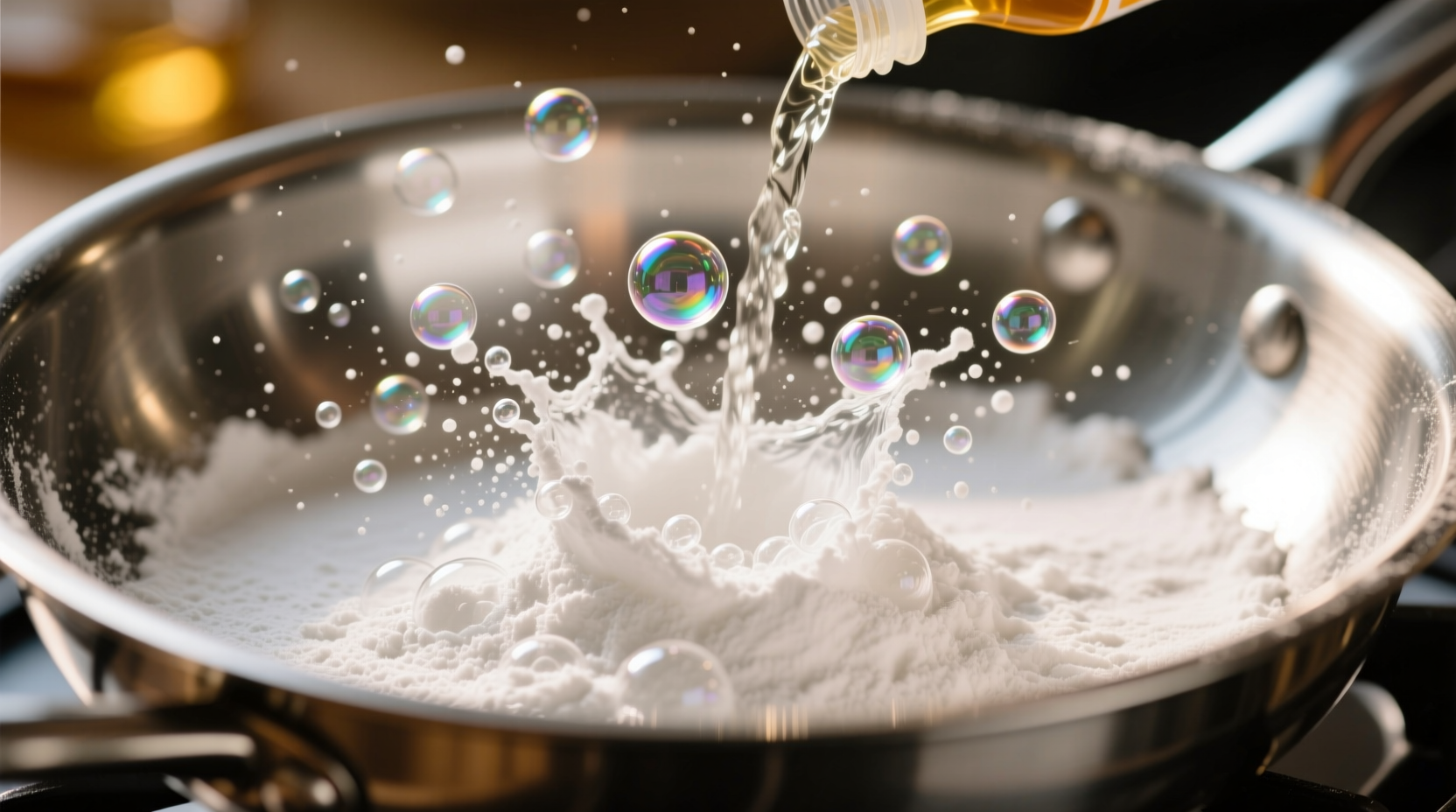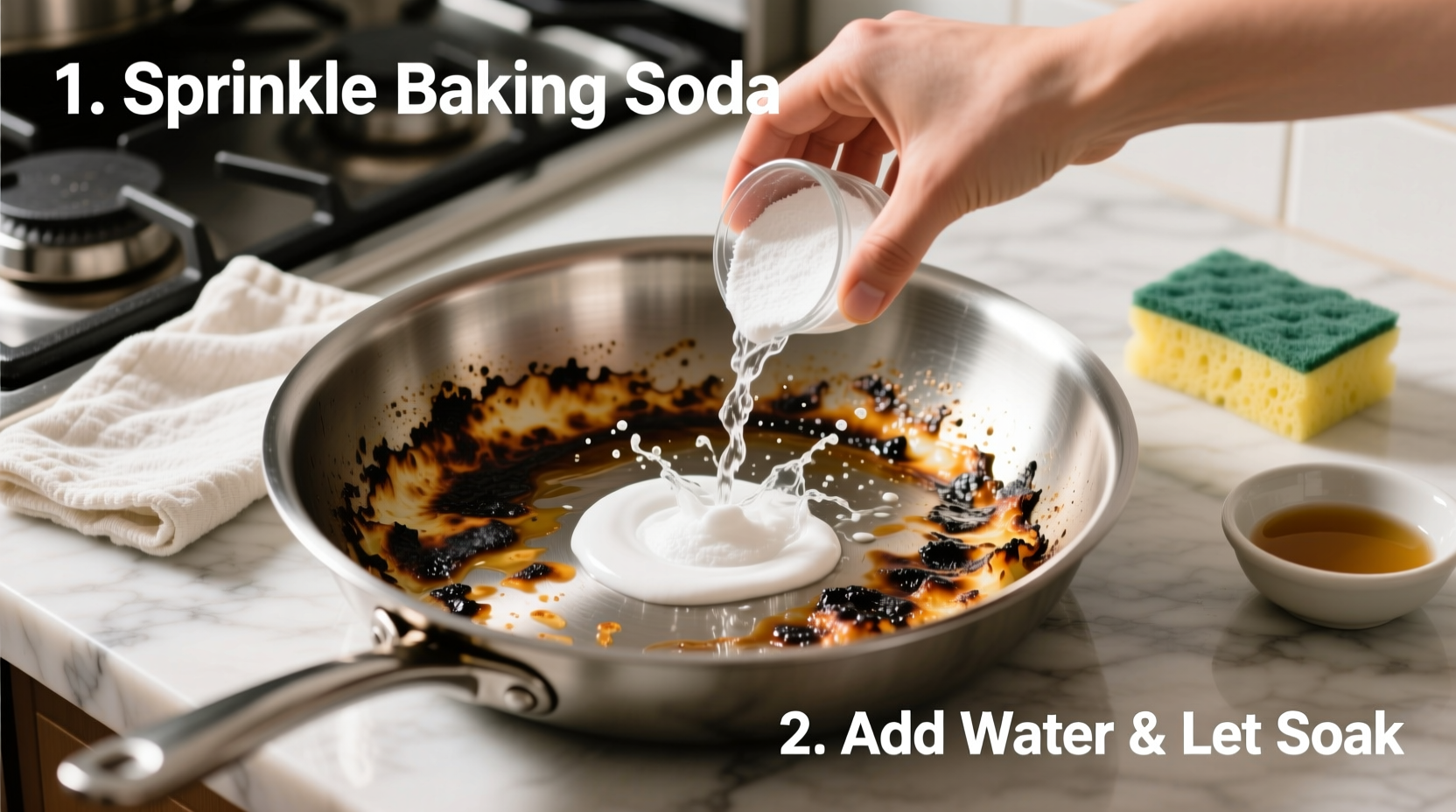That moment when you discover a layer of burnt food cemented to your favorite pan—it's enough to make any home cook panic. But before you reach for steel wool or consider tossing the pan, take a breath. Removing stubborn burnt residue doesn't require harsh chemicals or elbow-shattering scrubbing. As a culinary professional who's handled thousands of kitchen emergencies, I've tested every method available. The truth? Most burnt pans can be restored with simple ingredients already in your pantry, using techniques that protect your cookware's integrity.
Immediate Action Plan for Burnt Pans
When you first notice burnt food in your pan, your immediate response determines how easy the cleanup will be. Don't make these common mistakes:
- Never plunge a hot pan into cold water—this can warp metal and create dangerous steam
- Avoid metal scrubbers on non-stick surfaces—they permanently damage the coating
- Don't let it sit overnight without treatment—dried residue becomes exponentially harder to remove
Instead, follow this immediate protocol while the pan is still warm (but not scalding hot):
- Remove loose food particles with a wooden spoon
- Add 1 inch of water to cover the burnt area
- Place back on low heat for 5 minutes
- Remove from heat and add 2 tablespoons of baking soda
- Let sit for 10 minutes before attempting removal

Science-Backed Cleaning Methods That Actually Work
Understanding why these methods work helps you choose the right approach for your situation. When food burns, proteins and carbohydrates undergo Maillard reaction and carbonization, creating complex polymers that bond tightly to metal surfaces. The following techniques break these bonds safely:
Baking Soda and Vinegar Reaction Method
This classic combination creates a gentle effervescence that lifts burnt residue without scratching:
- Cover the burnt area with 1/4 inch of baking soda
- Pour white vinegar over the baking soda until it bubbles vigorously
- Let the mixture bubble for 5 minutes
- Add 1 cup of hot water and simmer for 10-15 minutes
- Cool slightly and wipe with a soft sponge
Why it works: The acetic acid in vinegar reacts with sodium bicarbonate to produce carbon dioxide bubbles that mechanically dislodge burnt particles, while the mild alkalinity of baking soda breaks down protein bonds.
Salt Abrasion Technique
Perfect for cast iron or stainless steel pans when residue is fresh:
- While the pan is still warm (not hot), sprinkle coarse salt generously over burnt areas
- Add 1-2 tablespoons of oil (vegetable or canola)
- Use a folded paper towel or soft cloth to scrub in circular motions
- Rinse thoroughly and re-season cast iron if needed
Pan Material Matters: Special Considerations
Not all pans respond to the same cleaning methods. Using the wrong technique can ruin your cookware. This comparison shows appropriate methods for different materials:
| Pan Type | Safe Methods | Methods to Avoid | Special Considerations |
|---|---|---|---|
| Non-stick | Baking soda paste, vinegar soak | Salt abrasion, metal scrubbers | Never use above medium heat during cleaning |
| Stainless Steel | All methods except steel wool | Steel wool on polished surfaces | Bar Keeper's Friend works for extreme cases |
| Cast Iron | Salt scrub, boiling water | Dish soap, vinegar soaks | Always re-season after cleaning |
| Copper | Lemon and salt | Vinegar, baking soda | Acids damage copper surfaces |
When to Use Overnight Soaking Methods
For severely burnt pans where immediate methods fail, these overnight solutions work while you sleep:
Dish Soap and Hydrogen Peroxide Soak
Ideal for stainless steel and enamel pans:
- Mix 1 part 3% hydrogen peroxide with 2 parts dish soap
- Cover burnt area completely with the mixture
- Cover with plastic wrap to prevent evaporation
- Let sit overnight
- In the morning, most residue will wipe away easily
Important safety note: According to the CDC, never mix hydrogen peroxide with vinegar as this creates peracetic acid, which can cause respiratory irritation.
Preventing Burnt Food Disasters
The best cleaning method is prevention. Follow these professional techniques to avoid burnt pans:
- Master heat control: Most burnt food occurs from using too high heat—start low and increase gradually
- Use the right oil: Oils with high smoke points (avocado, refined canola) resist burning better than olive oil
- Never leave cooking unattended: Set timers for critical cooking stages
- Proper pan selection: Use heavier-bottomed pans for delicate sauces and reductions
When to Consider Professional Help or Replacement
Some situations require more than home remedies:
- If the pan has warped from extreme heat, it won't heat evenly even after cleaning
- Non-stick coatings with visible scratches should be replaced for food safety
- Severe pitting in aluminum pans creates food safety hazards
- When cleaning takes longer than replacing the pan (consider cost vs. time)
Final Pro Tips for Burnt Pan Emergencies
Professional kitchens face burnt pans daily—here's what they do differently:
- Keep a dedicated 'burnt pan' sponge that's slightly more abrasive than regular dish sponges
- Store baking soda in your stovetop drawer for immediate access during cooking emergencies
- For stainless steel, the 'magic eraser' technique works wonders when combined with hot water
- Never use oven cleaner on cookware—it contains chemicals unsafe for food contact surfaces
Can I use baking soda to clean non-stick pans without damaging them?
Yes, baking soda is safe for non-stick pans when used properly. Create a paste with water (not vinegar) and apply with a soft sponge using gentle circular motions. Avoid abrasive scrubbing and never use baking soda with metal scrubbers. Rinse thoroughly after cleaning to prevent any residue buildup that could affect the non-stick coating over time.
How long should I soak a badly burnt pan?
For moderately burnt pans, 15-30 minutes of simmering in a baking soda solution is usually sufficient. Severely burnt pans may require 8-12 hours of soaking. Never leave pans soaking overnight with vinegar solutions as the acid can damage certain metal surfaces. For extended soaking, use a baking soda and water mixture which is pH neutral after the initial reaction.
Why shouldn't I use steel wool on stainless steel pans?
While stainless steel is durable, steel wool leaves fine scratches that create microscopic grooves where food particles and bacteria can accumulate. Over time, these scratches cause discoloration and make the pan harder to clean. For stainless steel, use nylon scrubbers or specialized stainless steel cleaning powders that clean without damaging the surface.
What's the fastest way to clean a slightly burnt pan?
The fastest method for slightly burnt pans is the hot water and baking soda technique: while the pan is still warm (not hot), add 1 cup of water and 2 tablespoons of baking soda, bring to a simmer for 5 minutes, then wipe clean with a soft sponge. This method typically takes less than 10 minutes total and works for most minor burnt food situations.
Can I fix a pan that's been burnt dry with no liquid?
Yes, but it requires more effort. Start by filling the cold pan with hot water to cover the burnt area, then place on medium-low heat for 10 minutes. Add 1/4 cup baking soda and simmer for another 15 minutes. For extreme cases, repeat the process or try the overnight hydrogen peroxide method. Never add cold water to a hot dry-burnt pan as the thermal shock can warp the metal.











 浙公网安备
33010002000092号
浙公网安备
33010002000092号 浙B2-20120091-4
浙B2-20120091-4